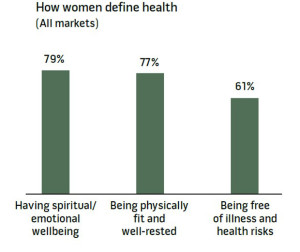The press release below was issued May 27 by the Society for Women’s Health Research and can be seen here. The Society for Women’s Health Research (SWHR ®), a national non-profit and thought leader in research on sex differences in health and disease, today announced “Beyond the Bruises,” an online campaign uniting survivors, advocates, organizations, and celebrities in bringing awareness to the effects of domestic violence on chronic disease. The campaign features a short film that shares the stories of domestic violence survivors who struggle with chronic disease as a result of their abuse, as well as the website BeyondtheBruises.org, a resource center that houses information on the often unrecognized effects of domestic violence on chronic illness. A 2013 study conducted by MORE Magazine and
Tag: advocacy
All women are health workers
The following post originally ran on Health Populi on May 26. See the original post here. The spiritual and emotional top the physical in women’s definition of “health,” based on a multi-country survey conducted in Brazil, Germany, Japan, the UK and the U.S. The Power of the Purse, a research project sponsored by the Center for Talent Innovation, underscores women’s primary role as Chief Medical Officers in their families and social networks. The research was sponsored by health industry leaders including Aetna, Bristol-Myers Squibb, Cardinal Health, Eli Lilly and Company, Johnson & Johnson, Merck & Co., Merck KGaA, MetLife, Pfizer, PwC, Strategy&, Teva, and WPP. The study’s summary infographic is titled How the Healthcare Industry Fails Women, which in itself is a sort of
Missed our Indoor Tanning Event, Don’t Fret…We’ve got a Recap
Our Skin Cancer Awareness Month series comes to a close today. Below is a recap of Wednesday’s event co-hosted with the Congressional Families Cancer Prevention Program, The Hazards and Allure of Indoor Tanning Beds on College Campuses. It was a late night call to Dr. Elizabeth Tanzi that made dealing with melanoma a personal experience. Tanzi, a dermatologist who previously had many difficult face-to-face conversations with patients to discuss a skin cancer diagnosis and subsequent treatment options, had decided to test a sample of her own skin after discovering noticeable symptoms. She had no risk factors, limited sun exposure, and at 37 years of age, she hadn’t been in a tanning bed since she was college-aged. But when she listened to her voicemail,
Birth of Pull the Plug on Tanning Beds
With May being Skin Cancer Awareness Month and in tandem with yesterday’s event co-hosted with the Congressional Families Cancer Prevention Program, The Hazards and Allure of Indoor Tanning Beds on College Campuses we are running a series on skin cancer. Be sure to check back daily for posts on skin cancer including how you prevent and detect it. Enjoy! Eight years ago, my daughter Jaime died from melanoma, which the doctors believed was from her use of tanning beds in high school and college. She was diagnosed when she was 20 and fought the evil beast of a disease until her death at 29. My Jaime’s story gave me the passion and conviction to become “the indoor tanning industry’s worst nightmare.” The day
Addressing the risks of indoor tanning
With May being Skin Cancer Awareness Month and in tandem with our event Wednesday co-hosted with the Congressional Families Cancer Prevention Program, The Hazards and Allure of Indoor Tanning Beds on College Campuses we are running a series on skin cancer. Be sure to check back daily for posts on skin cancer including how you prevent and detect it. Enjoy! It is not the kind of selfie we usually expect to see on Facebook. A young woman looks forlornly away from the camera, her face covered from top to bottom with bloody scabs—the result of treatment for skin cancer. The therapy is aggressive; but it is necessary, because at the age of just 27, Tawny Willoughby has had carcinoma six times. Almost every time she sees the
Nurse Executives & Nail Salons
I’ve been eyeing my colleagues’ manicures lately – a wardrobe staple, now that I work in nursing administration. The higher the title, the fancier the nails, it seems. Gone are the days where my closely trimmed, bare nails matched my simple scrubs. Dry cleaned suits and pumps are job requirements, and tasteful manicures seem highly recommended. Recently, I’ve considered picking up the practice, keeping my hands in my lap with rookie shame. I learned early on in my nursing career that the intensive care unit was no place for manicured fingernails, but administration is a different story. The on-and-off of latex gloves, constant washing, and ever-present hand sanitizer that nixed my polish in a single shift aren’t as present as I walk the halls







